Science
CaSSIS mission: The camera capturing Mars' craters and canyons – BBC News

It is a busy time for Mars at the moment.
This month the Red Planet entered its new year, what is known as Year 36, and it has not long been overtaken by Earth in its orbit of the Sun.
Many are anticipating the touchdown of Nasa’s Perseverance rover – the most sophisticated vehicle ever sent to land on a planet – on 18 February.
However, the Red Planet is already being closely observed.
Since its launch in 2016 and its subsequent orbit insertion around Mars, an instrument named the Colour and Stereo Surface Imaging System (CaSSIS) has been used to enhance scientists’ knowledge of the planet’s surface.
The camera is travelling with the European Space Agency’s (Esa) Exomars Trace Gas Orbiter, which is studying methane and other rare gases in the Martian atmosphere.
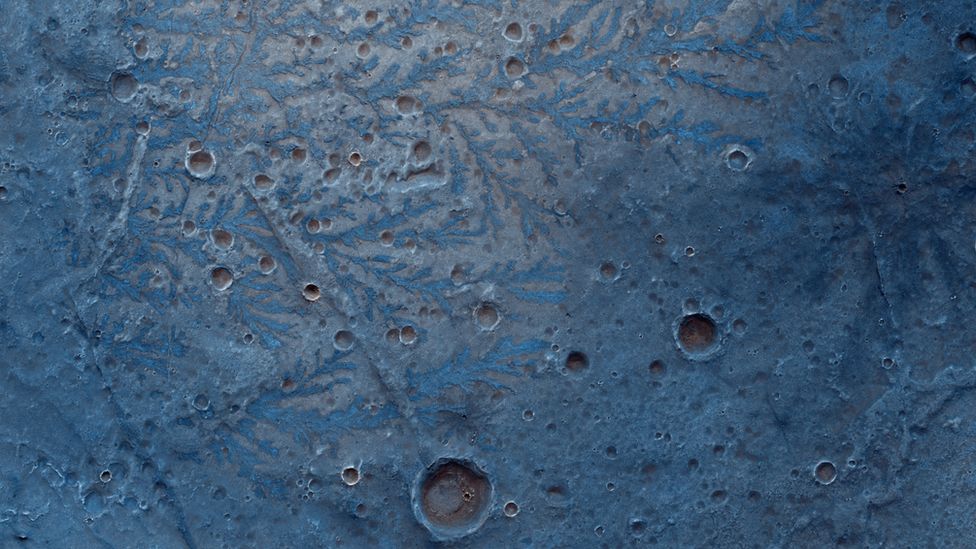

The technical goal of CaSSIS is to look at potential landing sites for future missions – one being Esa’s Exomars mission that is due to launch in 2022.
However, as part of its scientific activities, it has also observed a variety of minerals, canyons, craters and other geological features on the surface.
The images, which have been published on Instagram, also show frost deposits and dust storms.
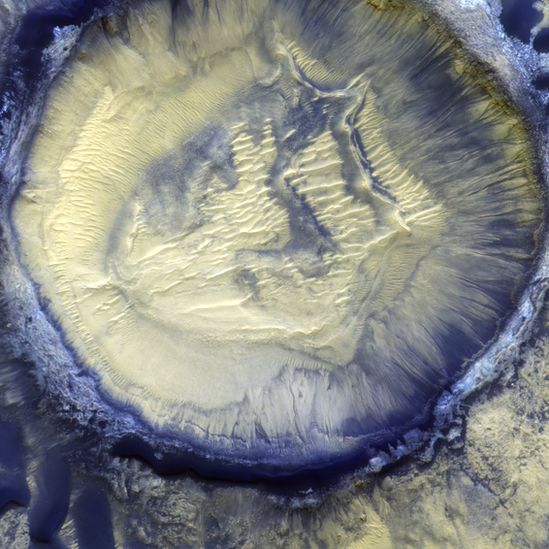




Prof Nicolas Thomas, from Oswestry in Shropshire, built the high-resolution instrument and leads the project at the University of Bern, Switzerland, which has now taken more than 20,000 images of Mars.
“There are things that we already know about, but we have got lots more information by using CaSSIS.
“The ability of CaSSIS to see sedimentary layering in some areas is very interesting,” he told BBC News.
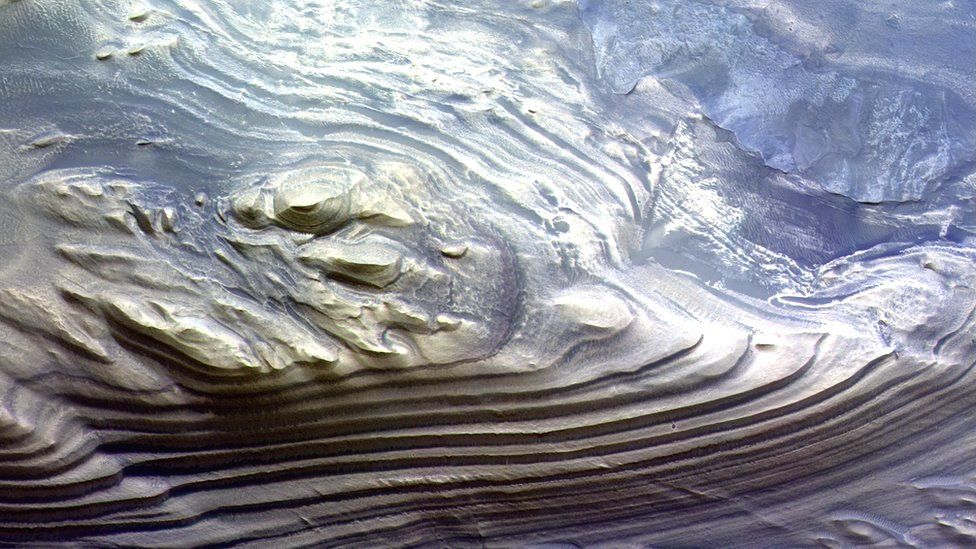

“The other thing I like is we have seen remarkable numerous dust devil tracks on the surface on Mars.
“It stands out in a way that it has never done when we used other instruments.”
Over the past few months, CaSSIS has been taking up to 300 images per week.
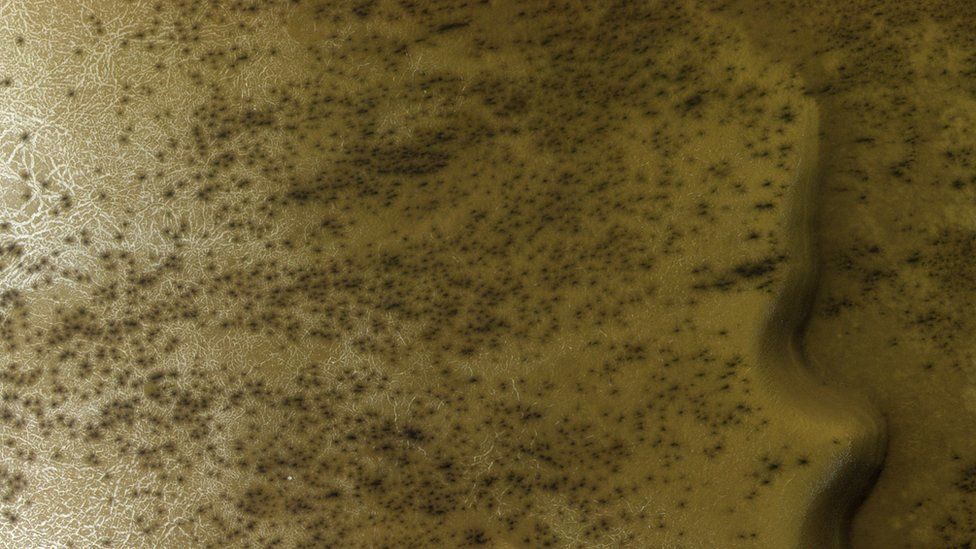

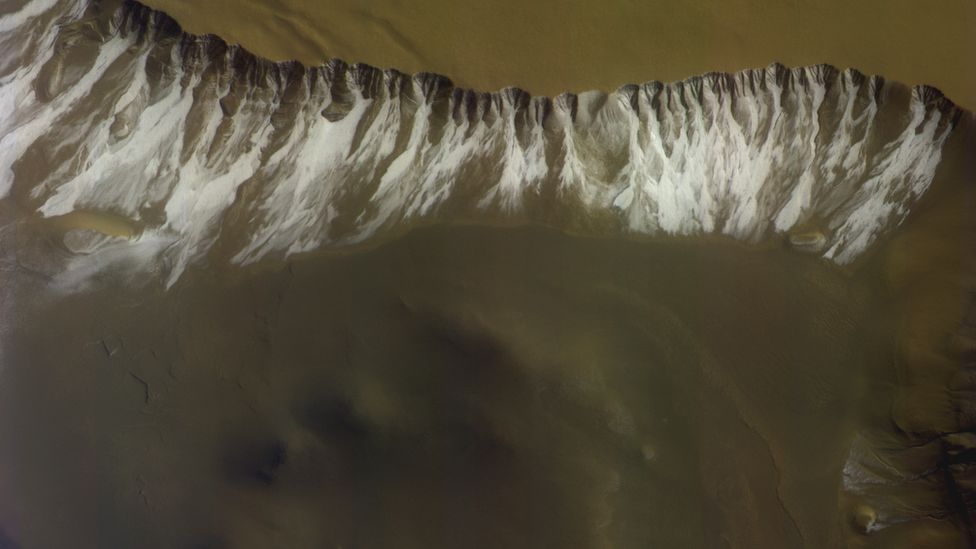

The instrument has a strong colour capability so the team combines its findings with those of Nasa’s ultra-high resolution imaging system, HiRISE, which flies on the Mars Reconnaissance Orbiter.
“We are very much working together right now in the scientific field,” Prof Thomas said.
An area of the Red Planet CaSSIS has photographed is a region near Sisyphi Tholus, where frost deposits have been documented.
At high latitudes, carbon dioxide ice and frost develop, which can be seen with the cracks in the terrain.
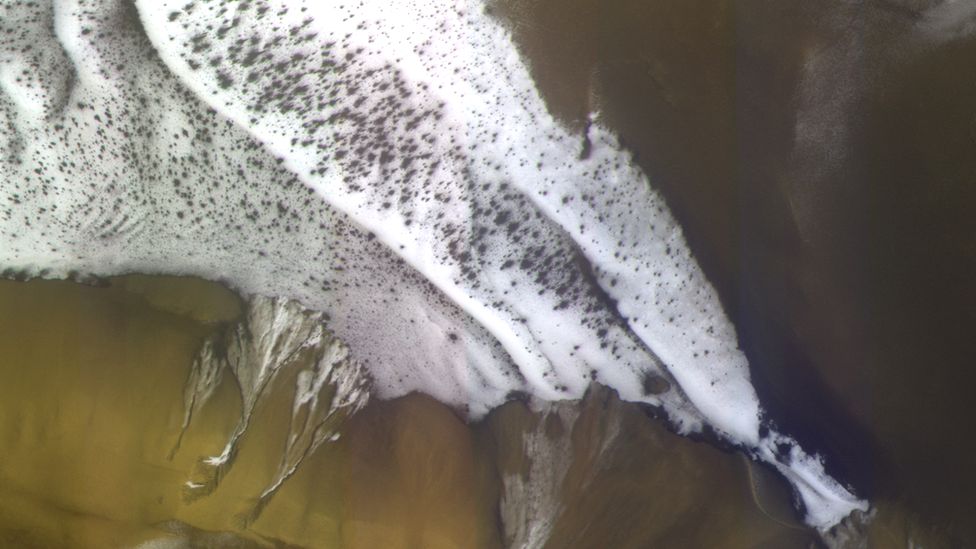




How does CaSSIS work?
The team selects specific targets from a database before capturing them.
CaSSIS flies over the surface at about 3km/s, so the images have to be taken very quickly. The exposure time for the images is only 1.5ms.
“We get around 4.5m per pixel on the surface from a distance of about 400 km – so it is a little looking at a bus in London from Liverpool,” Prof Thomas explains.
The camera uses false-colour imagery to enrich its findings.
The colours differ from how they would appear to the human eye, but it helps the CaSSIS team search for different minerals that reflect sunlight in different colours.
“We wanted CaSSIS to do science so we decided not to put simple red, green and blue colours into the camera system, but optimise the colours for science return,” Prof Thomas added.



One of the sites the CaSSIS team has looked at is the Jezero Crater.
This is where Nasa’s Perseverance rover is due to land next week before it starts its search for evidence of past life on the planet.
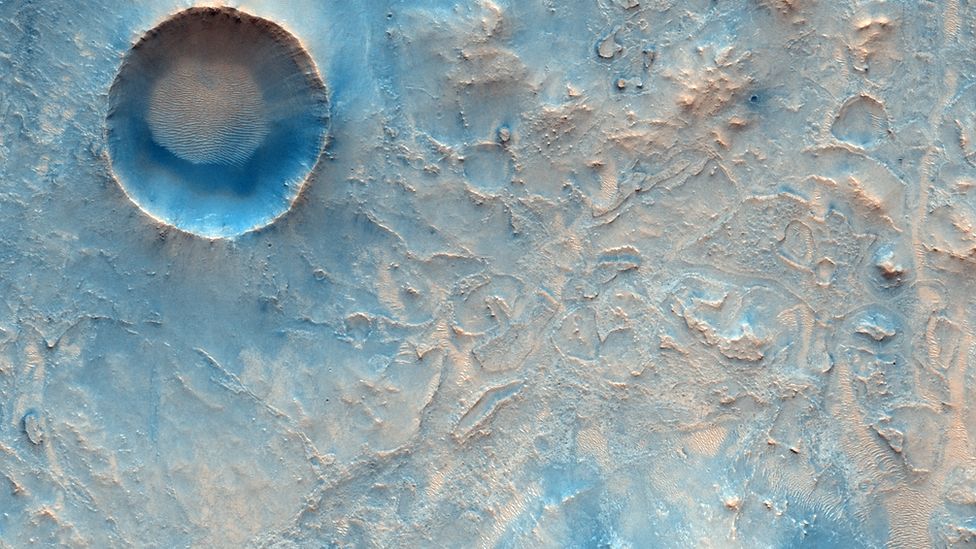

Prof Thomas said the team typically has four to six opportunities per year to take pictures of sites like Jezero.
Five days after the expected touchdown of Perseverance, CaSSIS hopes to capture its parachute and heat-shield discarded during the landing.
“We’ve got permission, so if it touches down successfully on the surface then all is good and we should see its heat-shield.
“However, if it lands upside down or in a wrong place somehow, then we will help search for it,” Prof Thomas added.
The camera will continue orbiting and is scheduled to assist ExoMars with its mission in 2022.
Prof Thomas is hoping the project will run until at least 2025.
Related Internet Links
Science
April 20: Why this Indigenous researcher thinks we can do science differently and more… – CBC.ca
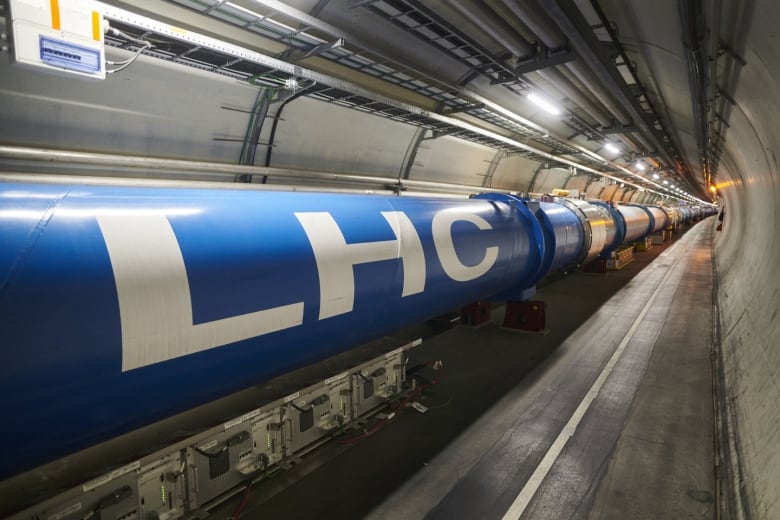

Quirks and Quarks54:00Why this Indigenous researcher thinks we can do science differently, and more…
On this episode of Quirks & Quarks with Bob McDonald:
This researcher wants a new particle accelerator to use before she’s dead
Quirks and Quarks9:05This researcher wants a new particle accelerator to use before she’s dead
Physicists exploring the nature of reality need ever more capable particle colliders, so they’re exploring a successor to the Large Hadron Collider in Europe. But that new machine is at least decades away. Tova Holmes, an assistant professor at the University of Tennessee, Knoxville, is one of the physicists calling for a different kind of collider that can come online before the end of her career – or her life. This device would use a particle not typically used in particle accelerators: the muon.
Is venting the best way to deal with anger? The scientist says chill out.
Quirks and Quarks6:51Is venting the best way to deal with anger? The scientist says chill out
It turns out that acting out your anger might not be the best way to get rid of it. Sophie Kjaervik, a researcher at Virginia Commonwealth University in Richmond, Va., analyzed 154 studies of the different ways to deal with anger. Her results, published in the journal Clinical Psychology Review, suggest that techniques that reduce your heart rate and calm your mind are more effective than blowing off steam.
High intensity wildfires may release toxic forms of metals
Quirks and Quarks8:37High intensity wildfires may release toxic forms of metals
Wildfire smoke might be more dangerous than you think. A recent study in the journal Nature Communications found that when wildfires pass over soils or rocks rich in a normally harmless metal called chromium, it is transformed into a toxic form. The hotter and more intense the wildfire is, the more of this metal becomes toxic. Scott Fendorf, an Earth system science professor at Stanford University, said this study shows we should factor in the type of geology wildfires pass over to provide more targeted air quality warnings about smoke risks.
AI might help solve the problem of runaway conspiracy theories
Quirks and Quarks7:35AI might help solve the problem of runaway conspiracy theories
Conspiracy theories seem to have multiplied in the internet era and so far, we haven’t had much luck in debunking these beliefs. The preliminary findings of a new study on PsyArXiv, a site for psychology studies that have yet to be peer-reviewed, suggests that artificial intelligence may have more success. Thomas Costello, a postdoctoral psychology researcher at MIT was the lead author on this study, and said their findings can provide a window into how to better debunk conspiracy beliefs.


An Indigenous scientist explores the medicine the Earth needs
Quirks and Quarks19:12An Indigenous ecologist on why we need to stop and listen to save the planet
Earth day is April 22. And Earth is not in great shape to celebrate the day. Overheated, overpopulated, overexploited – we’re not being particularly careful with our planet. We talk to Indigenous ecologist Jennifer Grenz of the University of British Columbia about her new book, which is part memoir, part prescription for the medicine our planet needs – a compound of science and traditional wisdom. Her book is Medicine Wheel for the Planet: A journey toward personal and ecological healing.
READ MORE: An Indigenous ecologist on why we need to stop and listen to save the planet


Science
Dragonfly: NASA greenlights most important mission of the century – Earth.com


In a remarkable development, NASA has given the green light to the Dragonfly mission, a revolutionary rotorcraft designed to investigate the complex chemistry of Saturn‘s moon Titan.
This confirmation allows the mission to proceed with the final design, construction, and testing of the spacecraft and its scientific instruments.
Deciphering the prebiotic chemistry on Titan
The Dragonfly mission, led by Dr. Melissa Trainer of NASA’s Goddard Space Flight Center, will carry a cutting-edge instrument called the Dragonfly Mass Spectrometer (DraMS).
This powerful tool will help scientists delve into the intricate chemistry at work on Titan, potentially shedding light on the chemical processes that led to the emergence of life on Earth, known as prebiotic chemistry.
“We want to know if the type of chemistry that could be important for early pre-biochemical systems on Earth is taking place on Titan,” explains Dr. Trainer, a planetary scientist and astrobiologist specializing in Titan.
Titan: Dragonfly’s target
Titan, the largest moon of Saturn, is shrouded in a dense nitrogen-rich atmosphere, bears a striking resemblance to Earth in many ways. With a diameter of 5,150 kilometers, Titan is the second-largest moon in our solar system, surpassed only by Jupiter’s Ganymede.
Dense atmosphere and unique climate
One of Titan’s most distinctive features is its thick atmosphere, which is composed primarily of nitrogen and methane. This dense atmosphere creates a surface pressure 1.5 times higher than Earth’s, making it the only moon in our solar system with a substantial atmosphere.
The presence of methane in Titan’s atmosphere leads to a fascinating hydrological cycle, similar to Earth’s water cycle, but with methane as the primary liquid.
Titan’s surface is dotted with numerous lakes and seas of liquid hydrocarbons, predominantly methane and ethane. These liquid bodies, some of which are larger than the Great Lakes on Earth, are the result of Titan’s unique climate and atmospheric conditions.
The Cassini mission, which explored the Saturn system from 2004 to 2017, provided stunning images and data of these extraterrestrial lakes and seas.
Dragonfly mission to search Titan for prebiotic chemistry and life
The complex chemistry occurring on Titan’s surface and in its atmosphere has drawn significant attention from astrobiologists.
With its abundant organic compounds and the presence of liquid methane, Titan is considered a prime candidate for studying prebiotic chemistry and the potential for life to emerge in environments different from Earth.
Beneath Titan’s icy crust lies another intriguing feature: a global subsurface ocean of liquid water and ammonia. This ocean, which is believed to be salty and have a high pH, may potentially host microbial life.
The presence of this subsurface ocean, along with the unique chemistry on Titan’s surface, makes this moon a fascinating target for future exploration and scientific research.
Pushing the boundaries of rotorcraft exploration
Nicky Fox, associate administrator of the Science Mission Directorate at NASA Headquarters, emphasized the significance of the Dragonfly mission, stating, “Exploring Titan will push the boundaries of what we can do with rotorcraft outside of Earth.”
Titan’s unique characteristics, including its abundant complex carbon-rich chemistry, interior ocean, and past presence of liquid water on the surface, make it an ideal destination for studying prebiotic chemical processes and the potential habitability of an extraterrestrial environment.
Innovative design and cutting-edge technology
The Dragonfly robotic rotorcraft will leverage Titan’s low gravity and dense atmosphere to fly between different points of interest on the moon’s surface, spanning several miles apart.
This innovative approach allows the entire suite of instruments to be relocated to new sites once the previous one has been thoroughly explored, providing access to samples from diverse geological environments.
DraMS, developed by the same team responsible for the Sample Analysis at Mars (SAM) instrument suite aboard the Curiosity rover, will analyze surface samples using techniques tested on Mars.
Dr. Trainer emphasized the benefits of this heritage, stating, “This design has given us an instrument that’s very flexible, that can adapt to the different types of surface samples.”
Dragonfly mission challenges and funding
The Dragonfly mission successfully passed its Preliminary Design Review in early 2023. However, due to funding constraints, the mission was asked to develop an updated budget and schedule.
The revised plan, presented and conditionally approved in November 2023, hinged on the outcome of the fiscal year 2025 budget process.
With the release of the president’s fiscal year 2025 budget request, Dragonfly is now confirmed with a total lifecycle cost of $3.35 billion and a launch date set for July 2028.
This reflects a cost increase of approximately two times the initially proposed cost and a delay of more than two years from the original selection in 2019.
Despite the challenges posed by funding constraints, the COVID-19 pandemic, supply chain issues, and an in-depth design iteration, NASA remains committed to the Dragonfly mission.
Additional funding has been provided for a heavy-lift launch vehicle to shorten the mission’s cruise phase and compensate for the delayed arrival at Titan.
Rigorous testing and validation
To ensure the success of the Dragonfly mission, researchers on Earth have conducted extensive testing and validation of the designs and models for the nuclear-powered, car-sized drone.
The mission team has carried out test campaigns at NASA’s Langley Research Center, utilizing the Subsonic Tunnel and the Transonic Dynamics Tunnel (TDT) to validate computational fluid dynamics models and gather data under simulated Titan atmospheric conditions.
Ken Hibbard, Dragonfly mission systems engineer at APL, emphasized the importance of these tests, stating, “All of these tests feed into our Dragonfly Titan simulations and performance predictions.”
As the Dragonfly mission progresses, it marks a new era of exploration and scientific discovery. Dr. Trainer expressed her excitement, saying, “Dragonfly is a spectacular science mission with broad community interest, and we are excited to take the next steps on this mission.”
Turning science fiction into fact with the Dragonfly mission
In summary, the Dragonfly mission embodies the essence of human curiosity and the relentless pursuit of knowledge. As NASA prepares to send this revolutionary rotorcraft to the alien world of Titan, we stand on the brink of a new era of exploration and discovery.
With its innovative design, cutting-edge technology, and the unwavering dedication of the mission team, Dragonfly will unlock the secrets of prebiotic chemistry and shed light on the potential for life beyond Earth.
As we eagerly await the launch of this titanic mission, we can only imagine the wonders that await us on Saturn’s enigmatic moon. The Dragonfly mission is a testament to the indomitable human spirit and our boundless capacity to push the frontiers of knowledge.
In the words of Ken Hibbard, “With Dragonfly, we’re turning science fiction into exploration fact,” and that fact will undoubtedly inspire generations to come.
—–
Like what you read? Subscribe to our newsletter for engaging articles, exclusive content, and the latest updates.
Check us out on EarthSnap, a free app brought to you by Eric Ralls and Earth.com.
—–
Science
Marine plankton could act as alert in mass extinction event: UVic researcher – Langley Advance Times


A University of Victoria micropaleontologist found that marine plankton may act as an early alert system before a mass extinction occurs.
With help from collaborators at the University of Bristol and Harvard, Andy Fraass’ newest paper in the Nature journal shows that after an analysis of fossil records showed that plankton community structures change before a mass extinction event.
“One of the major findings of the paper was how communities respond to climate events in the past depends on the previous climate,” Fraass said in a news release. “That means that we need to spend a lot more effort understanding recent communities, prior to industrialization. We need to work out what community structure looked like before human-caused climate change, and what has happened since, to do a better job at predicting what will happen in the future.”
According to the release, the fossil record is the most complete and extensive archive of biological changes available to science and by applying advanced computational analyses to the archive, researchers were able to detail the global community structure of the oceans dating back millions of years.
A key finding of the study was that during the “early eocene climatic optimum,” a geological era with sustained high global temperatures equivalent to today’s worst case global warming scenarios, marine plankton communities moved to higher latitudes and only the most specialized plankton remained near the equator, suggesting that the tropical temperatures prevented higher amounts of biodiversity.
“Considering that three billion people live in the tropics, the lack of biodiversity at higher temperatures is not great news,” paper co-leader Adam Woodhouse said in the release.
Next, the team plans to apply similar research methods to other marine plankton groups.
Read More: Global study, UVic researcher analyze how mammals responded during pandemic
-
Media18 hours ago
DJT Stock Rises. Trump Media CEO Alleges Potential Market Manipulation. – Barron's
-
Media20 hours ago
Trump Media alerts Nasdaq to potential market manipulation from 'naked' short selling of DJT stock – CNBC
-
Investment19 hours ago
Private equity gears up for potential National Football League investments – Financial Times
-
Real eState11 hours ago
Botched home sale costs Winnipeg man his right to sell real estate in Manitoba – CBC.ca
-
News17 hours ago
Canada Child Benefit payment on Friday | CTV News – CTV News Toronto
-



 Sports23 hours ago
Sports23 hours ago2024 Stanley Cup Playoffs 1st-round schedule – NHL.com
-
Business19 hours ago
Gas prices see 'largest single-day jump since early 2022': En-Pro International – Yahoo Canada Finance
-
Art22 hours ago
Enter the uncanny valley: New exhibition mixes AI and art photography – Euronews





